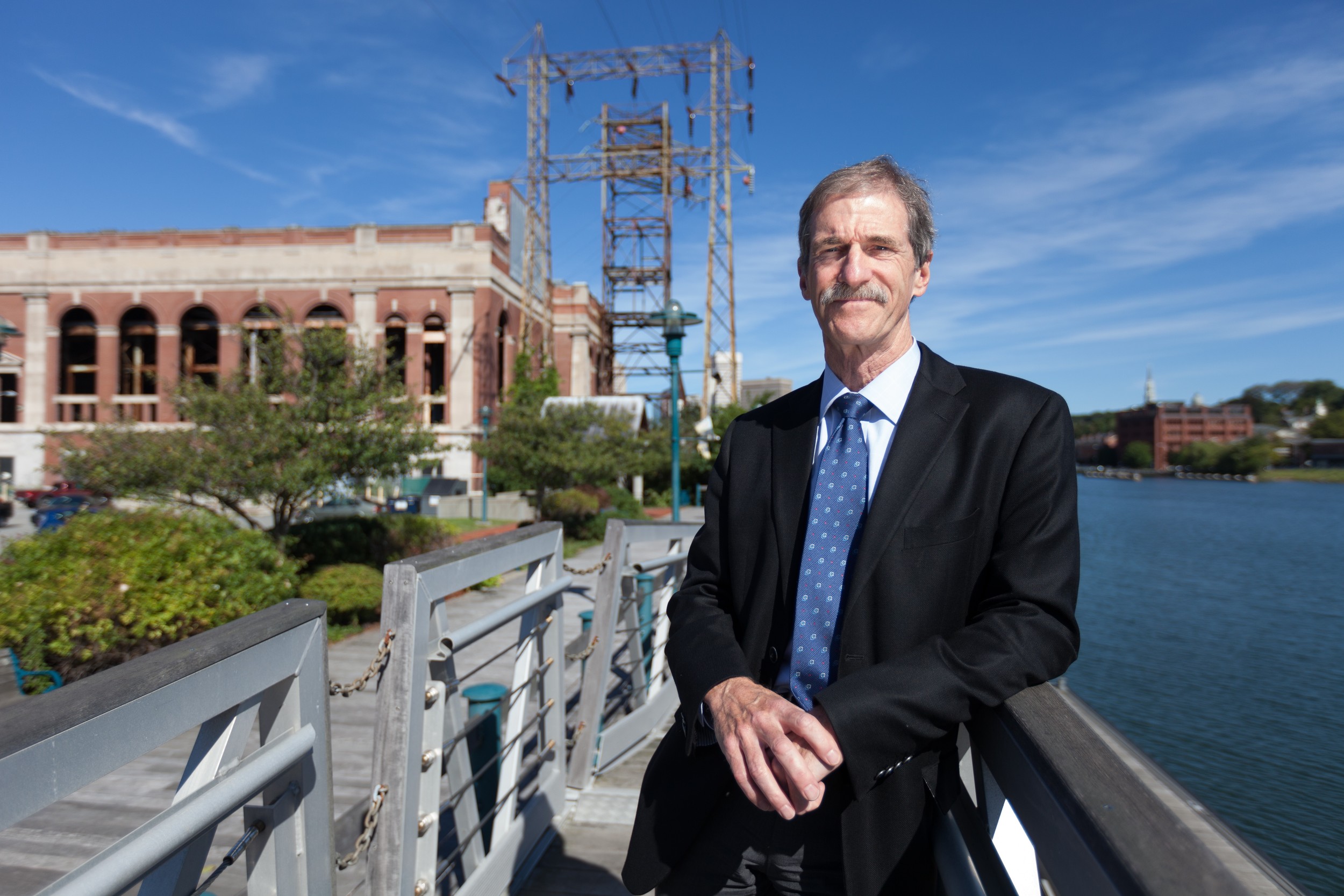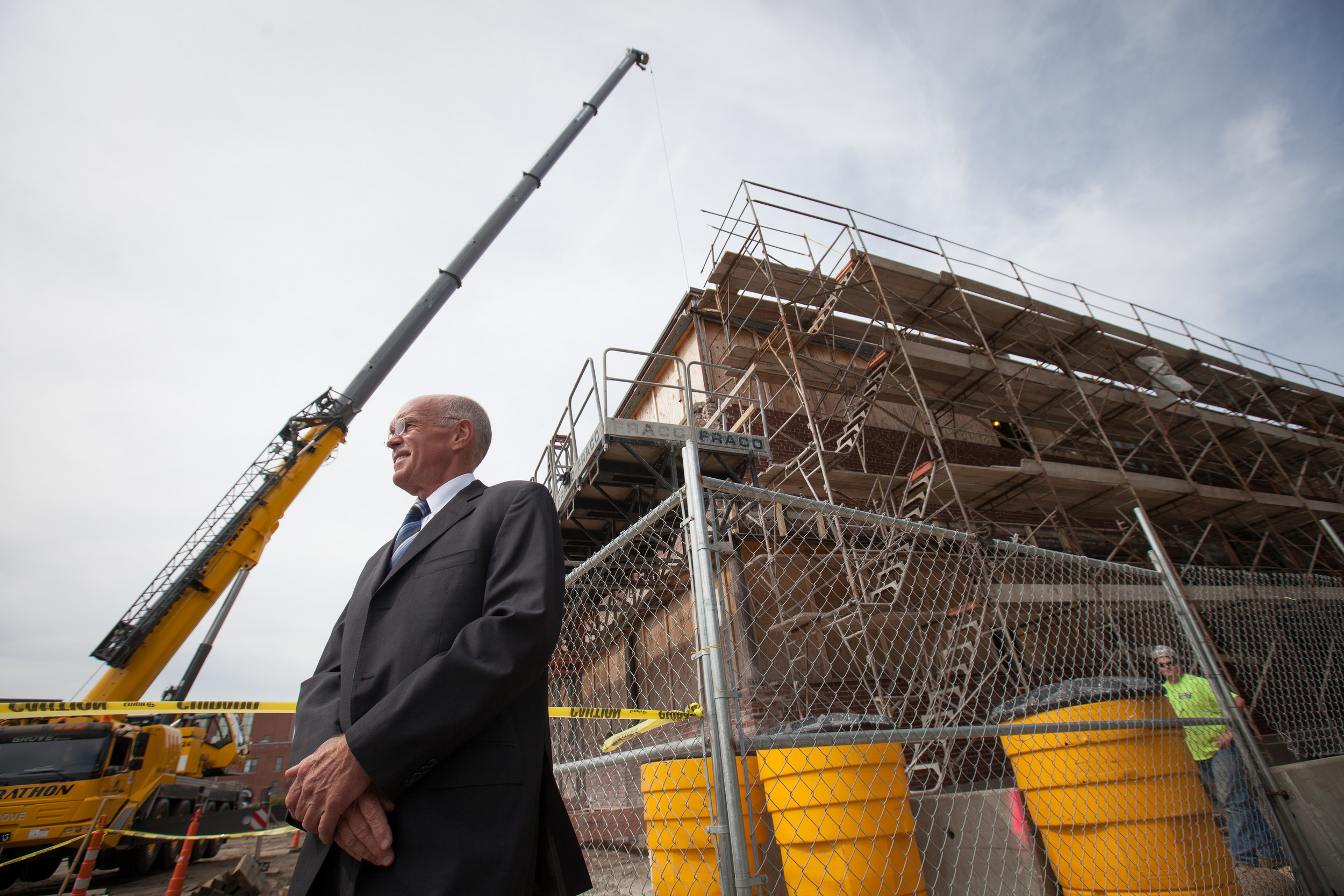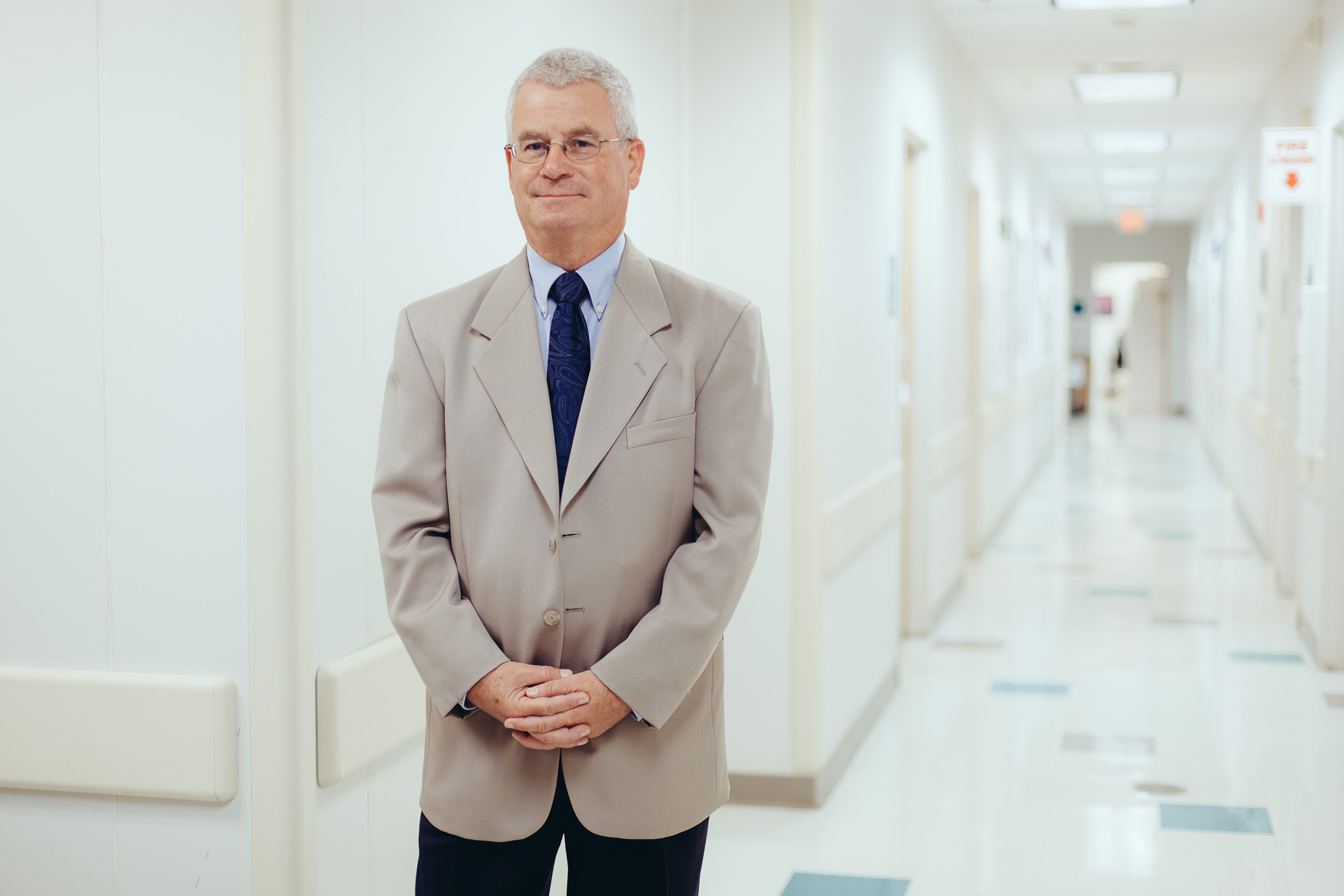What defines the emerging Knowledge District?
Connectivity, collaboration, and human-scale walkability are high on list of valued attributes
EpiVax founder and CEO Dr. Anne De Groot, sitting with Dr. Dre, a rescue dog, on the steps of the building that served as her first lab space, now a tattoo studio.
“I think the Knowledge District is emerging. I think whatever they do, it should be about connectivity, it has be in walking distance, it has to be personal, it has to be human-sized.
What’s ideal about this area is, if you don’t have equipment, you can walk over to the site that does have it, and do your assay. You don’t have to get in the car and drive, you don’t have to buy the machine. It creates relationships around those connections.
It’s the old Jewelry District, which was nitty-gritty. You don’t think of [the existing] buildings as being anything really fabulous. But we create great spaces within them to do the creative work that we’re doing. It makes you think about creativity and making things.
It’s not about just putting up pretty edifices. Which is kind of what I think that the 195 Commission has in their minds.
I think there are some things about the space that should be preserved. It should still be funky. It should have an artist’s flavor to it. There are artists in those old jewelry lofts. Let’s have an integrated artist, residential and biotechnology space – a place that people will want to come to work.”
Denice Spero and Dr. Lars Wahlberg, the startup team at NsGene, near their offices at 225 Chapman St. in Providence.
Spero:
“Some people don’t like calling it the Knowledge District, because if you’re outside of it, does it mean that you’re not knowledgeable? I see it a little more broadly. People are using it to describe a specific space, where the freeway came down. We’re here on Chapman Street; there are other companies here. I see it as a big Providence community.”
Wahlberg:
“If you include the University of Rhode Island (we were down there two weeks ago, looking at their new facility where they can do manufacturing of experimental drugs, and we will likely interact with them as well), it’s really a ‘Knowledge Corridor.’ We don’t see it as a physical location. It’s more about how the people are connected.”
Spero:
“The important thing is to have the people talking together, which I think we do have now in Rhode Island.”
Wahlberg:
“Maybe it should be called the ‘Knowledge State,’ rather than the Knowledge District.
John Robson, administrative director, Norman Prince Neurosciences Institute
“We shouldn’t think of this district as just buildings. We should think of it as a sector of the city, as developing a whole region.
You don’t want to have only fancy research buildings, you want to build a community as well. It would be nice if there were student housing, if there were restaurants. Then everything will grow up around it.
If you seed it with people, the other things that you want, the small shops, the cafes, the grocery stores, will happen.
The fact that everyone is in walking distance makes a difference. People have collaborations across international boundaries; you can do these things with electronic communications. The BrainGate project has regular video conferences once a week, connecting with Palo Alto and Cleveland.
But if you can see the other person, bump into them, it’s more conducive to working together. It makes collaboration easier.”
George Bottomley, director of Johnson & Wales University’s Center for Physician Assistant Studies
“I look at it now not as a place where jewelry was manufactured, but where there are lots of gems.
Brown is one of the more incredible gems, with its medical school. Johnson & Wales has an incredible presence in downtown Providence. The Center for Physician Assistant Studies is right across from the administrative offices for Lifespan, the other side of the street is Brown’s Center for Molecular Medicine.
It’s an incredible area that keeps expanding – especially with Brown’s acquisition of the Dynamo Building, with the plan to bring Rhode Island College’s and the University of Rhode Island’s nursing programs under one umbrella there.
Together, it really creates this incredible inter-professional jewel, if you will, an inter-professional jewel of medical care.
There are only a few other places in the country – in New Haven around Yale, in Houston around Baylor Medical School, in the Longfellow District in Boston – where you have this kind of convergence of research, medical care, providers, and educational institutions happening.”
Peter Snyder, senior vice president and chief research officer for Lifespan, in front of the Coro Building
“There’s a lot of momentum building around the Knowledge District. The research mission and infrastructure that is supported by the hospital system will play a key role in the growth of the Knowledge District.
The first is a physical presence. The Coro Building is 270,000 square feet; it’s arguably the gateway to the Knowledge District. We’re halfway toward our goal to convert all of the space to a major research center.
We also provide a lot of the infrastructure to support the laboratory research at Care New England’s Kilguss Research Institute.
Beyond that, there is the human capital. We’re adding jobs; these are good-paying jobs. As tight as finances are for Lifespan system overall, and they are tight, we are still maintaining real strength on our research side. The academic medical center remains one of our key missions.”
Dr. G. Alan Kurose, president and CEO of Coastal Medical Group, whose offices are at 10 Davol Square.
“For us, up to this point, the benefits of our location in the Knowledge District is mostly the proximity to Rhode Island Hospital and the [Warren Alpert] Medical School, and the proximity of what is now the Brown University School of Public Health. We have interactions with all those entities – entities in this close geographic location that we have regular interactions and shared work.
But as far as connections to a larger network outside of those entities that are working in the same space, that hasn’t really happened for us yet.
The decision to be here was made before my tenure and administrative leadership. It’s a legacy condition.
I’m not sure I understand what the nature of a conversation would be [regarding the future of the Knowledge District]. It certainly seems like there would be value in a more collaborative discussion.”
Dennis D. Keefe, president and CEO of Care New England
“In these few blocks lie possibilities that are boundless. We are talking about the Warren Alpert Medical School of Brown University, two major health systems, key physician organizations, pioneering researchers, creative artists and thinkers – the convergence of all these forces coming together can spark synergies and new levels of inquiry, discovery and innovation. Let the conversations continue – and the new ones begin!”
OPINION
Conversation and Convergence
In 1997, an effort was undertaken to brand the Jewelry District, with metal signage attached to numerous street signposts throughout the district.
The sprite figure on the sign was then “recycled” as part of United Way of Rhode Island’s marketing campaign later that year by the ad agency that designed the metal signage.
One of the few remaining signs of that ad agency-promoted branding effort still hangs on the street signpost on the corner of Chestnut and Elm streets.
Sixteen years later, as the Interstate 195 Redevelopment District Commission begins to market the land to developers, the commission is considering a new, catchier name for itself, such as “Riverlink” and “Relink.”
The remaining sign from the previous branding effort may offer some historical guidance on what doesn’t work: a clever name, a snazzy sign or an upbeat slogan promoted by a well-connected ad agency will not make a branding campaign successful, even if it’s in Rhode Island’s own backyard.
As Richard Horan says so well: “I think projecting a provenance for such a district can be problematic, particularly when done pursuant to political fiat, as seems the mode of action with the Knowledge District thus far.”
The hallmark of the Rhode Island’s emerging knowledge economy and its innovation ecosystem is collaboration across boundaries, and conversation that is inclusive.
Institutions that have long held the reins of power in decision-making – whether it be newspapers, hospitals, insurance companies, universities, well-connected firms or elected officials – are finding that people in the digital economy no longer respond to their button pushing.
In Rhode Island, in the health care reform evolution, the delivery of care is shifting from hospital-centric to patient-centric. In health insurance, the new exchange is opening up choice for employees.
What will define the emerging Knowledge District? Will it be more than the ROI on real estate developed by the 195 Commission? Are there equally important values and metrics to be preserved? And, who gets to participate in the conversation?
ConvergenceRI asked a number of scientists, researchers, CEOs and entrepreneurs who live, work and thrive in the state's innovation ecosystem to share their views and captured those vantage points in a photo essay.
The idea behind this photo essay and conversation owes much to the work of Jane Jacobs and Norton Juster who championed the importance of shared observation.
What is your view of the Knowledge District? How would you define it? Send us a photo of yourself and your ideas, and we’ll publish them as part of an ongoing conversation.

![EpiVax founder and CEO Dr. Anne De Groot, sitting with Dr. Dre, a rescue dog, on the steps of the building that served as her first lab space, now a tattoo studio.
“I think the Knowledge District is emerging. I think whatever they do, it should be about connectivity, it has be in walking distance, it has to be personal, it has to be human-sized.
What’s ideal about this area is, if you don’t have equipment, you can walk over to the site that does have it, and do your assay. You don’t have to get in the car and drive, you don’t have to buy the machine. It creates relationships around those connections.
It’s the old Jewelry District, which was nitty-gritty. You don’t think of [the existing] buildings as being anything really fabulous. But we create great spaces within them to do the creative work that we’re doing. It makes you think about creativity and making things.
It’s not about just putting up pretty edifices. Which is kind of what I think that the 195 Commission has in their minds.
I think there are some things about the space that should be preserved. It should still be funky. It should have an artist’s flavor to it. There are artists in those old jewelry lofts. Let’s have an integrated artist, residential and biotechnology space – a place that people will want to come to work.”](/uploads/original/1379791346_7437.jpg)




![Dr. G. Alan Kurose, president and CEO of Coastal Medical Group, whose offices are at 10 Davol Square.
“For us, up to this point, the benefits of our location in the Knowledge District is mostly the proximity to Rhode Island Hospital and the [Warren Alpert] Medical School, and the proximity of what is now the Brown University School of Public Health. We have interactions with all those entities – entities in this close geographic location that we have regular interactions and shared work.
But as far as connections to a larger network outside of those entities that are working in the same space, that hasn’t really happened for us yet.
The decision to be here was made before my tenure and administrative leadership. It’s a legacy condition.
I’m not sure I understand what the nature of a conversation would be [regarding the future of the Knowledge District]. It certainly seems like there would be value in a more collaborative discussion.”](/uploads/original/1379863671_ae85.jpg)






